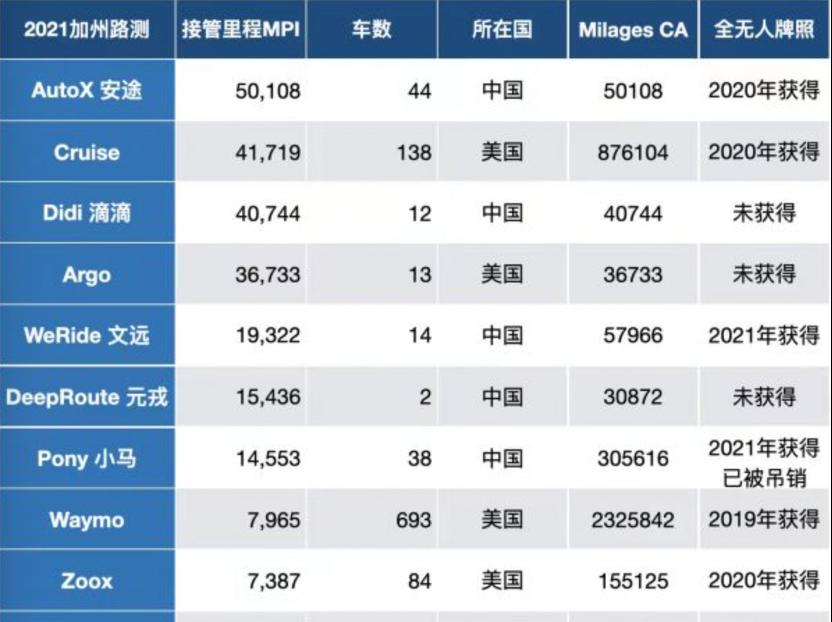On February 10, the California Transportation Administration (DMV) released data on autonomous driving for the whole year of 2021. Based on miles per intervention, one of the core metrics for autonomous driving, the top five companies are AutoX (China), Cruise (US), Didi Didi (China), Argo (US), and WeRide Wenyuan Zhixing (China).
In addition, Yuanrong Qixing DeepRoute ranked sixth, Xiaoma Zhixing Pony.ai ranked seventh, and Baidu Baidu ranked eleventh. In the top ten, 5 are Chinese companies and 5 are American companies.

According to the DMV report, in terms of autonomous driving accidents in 2021, Wenyuan Zhixing had 3 cases and Xiaoma Zhixing had 2 cases.
In terms of the size of the self-driving fleet, Google's Waymo ranked first with 693 vehicles, while the other two Chinese companies, AutoX Andu and Pony.ai Xiaoma Zhixing, ranked fourth and fifth, respectively.
California currently has the largest number and longest number of global self-driving companies, collects a large amount of test data each year, and is the first fully driverless licensing body. Since 2015, companies conducting autonomous driving tests on public roads in California have been required to submit road test reports to DMVs every year, listing the number of road test miles and manual takeovers. "Disengagement" refers to a situation in which a human safety officer must take over an automated driving system due to a malfunction in the autopilot system or for driving safety reasons.
For most people, self-driving companies may be a black box, companies often only show their technology in the most controlled environment, and it is difficult for the outside world to clearly judge the actual progress of different companies. The average annual takeover mileage, the average number of miles driven by autonomous driving, needs to be intervened once and is often considered a more objective, quantifiable and accurate measure than the test drive experience.
It is also in this way that this annual automatic driving data, which is released regularly every year, has attracted much attention. At the same time, it is also controversial because it is one of the most public quantitative evaluation criteria.
"Comparing intercompany intervention rates is worse than pointless: It creates perverse incentives," Bryant Walker Smith, an associate professor at the University of South Carolina Law School and an expert on self-driving cars, once said in an interview with The Verge, "for example, doing a lot of highway driving in California and then doing real testing anywhere else." ”
The number of road sections tested by each company varied widely, and the number of manual takeovers could naturally vary from wide and open highways to busy city centres. At the same time, each company reports its own data, while the criteria for different companies to decide whether to take over manually are not uniform in themselves.
Martin Greenstein, DMV's public information officer, has also noted that while these reports are required of licensee, they should not be used to "compare one company to another or draw broad conclusions about technical capabilities."